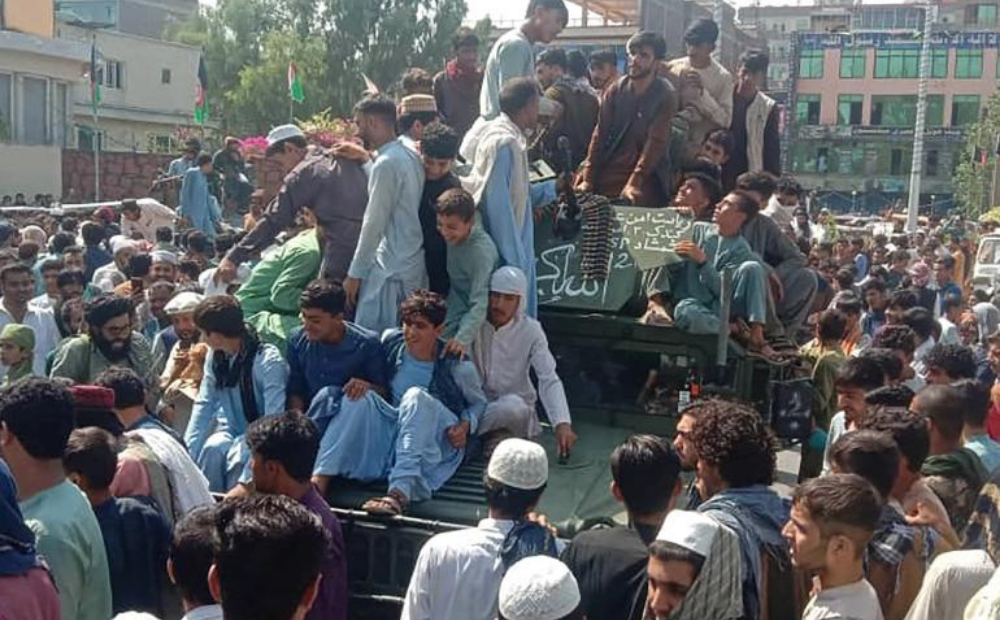Photo credit: AFP
Taliban fighters and local people seen sitting on an Afghan National Army (ANA) humvee vehicle on a street in Jalalabad province on August 15, 2021
The Taliban’s lightning offensive in Afghanistan this past weekend which saw the Afghan military hand over the country to the armed group without putting up a real fight brought back memories of the ISIL (ISIS) group’s 2014 invasion of Iraq which led to the collapse of the country’s army.
In response to the latest events in Afghanistan, international media published articles with headlines such as “How the Taliban Overran the Afghan Army, Built by the US Over 20 Years”, and asked questions like “The US Spent $83 Billion Training Afghan Forces. Why Did They Collapse So Quickly?”
Similar questions had regularly been raised about the Iraqi army in the past (I answered some of these questions in a recent journal article). And the explanations provided for the many failures of the Iraqi military since the 2003 US invasion can be useful in understanding the reasons behind the Afghan military’s recent collapse.
Indeed, despite the many fundamental differences between the situations in Iraq and Afghanistan, military failures of both states were caused by the same three factors:
First, the United States sought to impose the rigid, hierarchical American military doctrine on both armies, without considering the differences in the Afghan and Iraqi cultural contexts.
Second, these enfeebled armies had to face off against either ISIL or the Taliban – violent non-state actors which possess a stronger “asabiyya” (group solidarity) than them.
Third, there were weak leaders both in Kabul and Baghdad – former Prime Minister Nuri al-Maliki in Iraq and recently departed President Ashraf Ghani in Afghanistan – resulting in ineffective administrations and faltering governance. Alongside the US, these leaders allowed networks of patronage and corruption to take root in their countries’ militaries during their respective rebuilding processes, enabling the eventual success of ISIL and the Taliban.
Intervention and failed state-building
Granted there are substantial differences between the histories as well as socioeconomic and ethno-sectarian compositions of Iraq and Afghanistan. But the collapse of Iraq’s military in 2014 and Afghanistan’s in 2021 can still be tied together for one reason: both debacles were the result of an American invasion and consequent failed state-building efforts.
Indeed, the US’s 2001 invasion of Afghanistan and 2003 invasion of Iraq both led to externally-imposed, securitised state-building processes that had devastating consequences for these countries and their security sectors.
After its invasions, the US excluded the Iraqis in the Baath party and military and Afghans in the Taliban from its state-building efforts. In response, both these groups turned to violence to undermine the new state and the military.
Peace-building is difficult even after the cannons have fallen silent, with Bosnia Herzegovina a good case in point. But both the Afghan and Iraqi states had to be rebuilt amid domestic armed uprisings.
In both cases, the uprisings emerged after the US military intervention led to a security vacuum. Occupying US forces had to assume the role of the domestic security provider while also working to create a new local military from scratch.
The problem is that in both cases the US efforts resulted in armies created in the image of the US military, with a rigid, centralised hierarchy. Washington hoped that these copy-cat armies would eventually develop the necessary capabilities to conduct large-scale ground operations with air support from the US. Neither army achieved this goal, which soon proved redundant anyway as both Afghanistan and Iraq became theatres of asymmetric warfare and armed groups’ attacks.
In both Afghanistan and Iraq, the US provided sophisticated weaponry to the new military forces, such as aircraft, but it soon became clear that local forces cannot maintain these complex equipment without a constant deployment of US military advisers on site. Other US weapons, including jeeps, armoured personnel carriers, artillery and tanks, ironically ended up in the hands of ISIL or the Taliban, resulting in the US taxpayer indirectly subsidising these groups.
Pervasive corruption
In June 2014, some 30,000 Iraqi soldiers could not prevent 1,500 ISIL fighters from taking over Mosul, Iraq’s second-largest city. This month, the Afghan security sector, including the army, air force, and police, officially numbered at more than 300,000, could not stand up to estimated 60,000 Taliban fighters.
Both militaries appeared a lot stronger and larger than their adversaries on paper, so what led to their humiliating defeats?
First and foremost, despite their massive official troop numbers, both forces have been struggling with significant structural deficiencies from the very beginning.
Both in Afghanistan and Iraq, widespread desertion and corruption prevented US-trained militaries from emerging as capable forces.
High-ranking officers in both militaries, for example, are known to have inflated their rosters with fictitious names and collected paycheques for these “ghost soldiers”. This practice emerged in both states, because the military served as a patronage network for the countries’ leaders and officer posts were awarded to political loyalists rather than those with military acumen. These politically connected officers used their positions to extract wealth for themselves, not only by inflating the rosters but also by taking a cut from the “transit fees” the soldiers under their command routinely collect from the public at checkpoints.
The state security forces’ corruption and predatory behaviour, especially at checkpoints, alienated local populations in both Iraq and Afghanistan. In her book, Thieves of State: Why Corruption Threatens Global Security, Sarah Chayes wrote about a disgruntled Afghan civilian who was so fed up with paying bribes to the post-2001 security forces that he wished for the Taliban to come and rid him of this nuisance. This anecdote is just one of many examples of how corruption deprived security forces in both countries of any legitimacy and public support prior to their spectacular defeats.
The historical legacy of a 20-year war
What we are witnessing today in Afghanistan, and what we have witnessed in Iraq some seven years ago, is the ultimate failure of not only the US’s interventions in these two countries but also its entire “war on terror” doctrine.
The US invaded Iraq and Afghanistan with the declared aim of eliminating terror groups and their supporters. It then embarked on a securitised state-building process that led to the US reconstituting the armed forces in both nations anew. These new institutions, however, have spectacularly failed to deal with the security vacuums brought about by the American invasions themselves. In the end, the US’s war on terror, rather than eliminating terror groups, led to these groups gaining more power. Indeed, 20 years after the invasion of Afghanistan, the Taliban is gearing up to take complete control of the country once again. Moreover, with the Taliban’s resurgence over the past weekend, there is a strong possibility that al-Qaeda will also re-emerge in the country. Al-Qaeda’s offshoot, ISIL, meanwhile, still persists both in Afghanistan and Iraq.
The current situation in Afghanistan is a direct result of the US’s actions, but for now, Washington does not seem willing to take any action to reverse its mistakes. It is not yet clear what security ramifications the US’s failure to build a strong and capable army in Afghanistan will be for Americans. It is clear, however, that this failure will have immediate and irreversible ramifications for millions of Afghans who are now facing the grim prospect of once again living under the Taliban’s oppressive rule. We have, after all, already seen a similar drama play out in Iraq, with devastating consequences.














